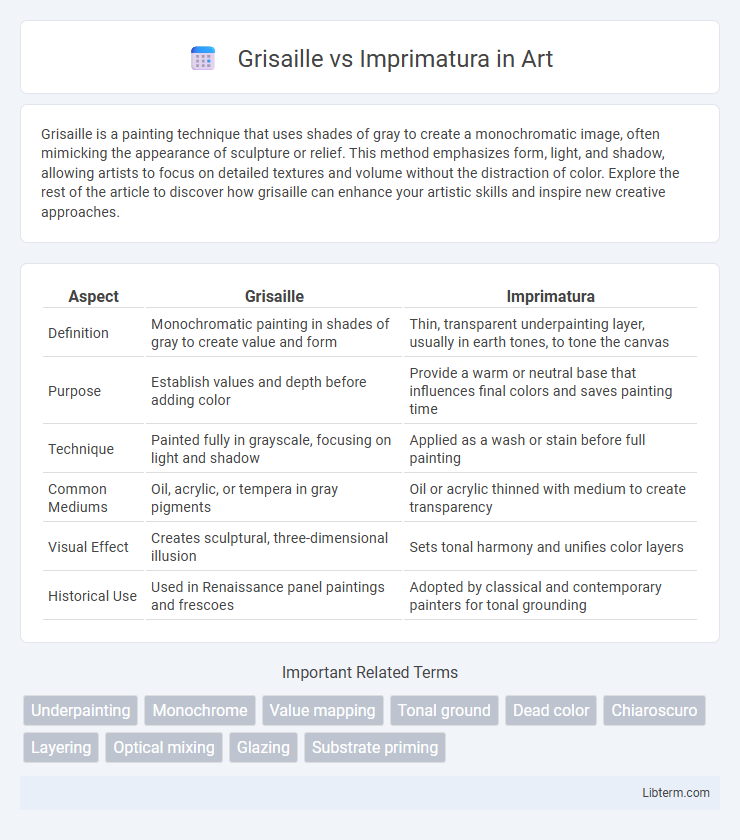Grisaille is a painting technique that uses shades of gray to create a monochromatic image, often mimicking the appearance of sculpture or relief. This method emphasizes form, light, and shadow, allowing artists to focus on detailed textures and volume without the distraction of color. Explore the rest of the article to discover how grisaille can enhance your artistic skills and inspire new creative approaches.
Table of Comparison
| Aspect | Grisaille | Imprimatura |
|---|---|---|
| Definition | Monochromatic painting in shades of gray to create value and form | Thin, transparent underpainting layer, usually in earth tones, to tone the canvas |
| Purpose | Establish values and depth before adding color | Provide a warm or neutral base that influences final colors and saves painting time |
| Technique | Painted fully in grayscale, focusing on light and shadow | Applied as a wash or stain before full painting |
| Common Mediums | Oil, acrylic, or tempera in gray pigments | Oil or acrylic thinned with medium to create transparency |
| Visual Effect | Creates sculptural, three-dimensional illusion | Sets tonal harmony and unifies color layers |
| Historical Use | Used in Renaissance panel paintings and frescoes | Adopted by classical and contemporary painters for tonal grounding |
Understanding Grisaille: Definition and Origins
Grisaille is a monochromatic painting technique using shades of gray to create depth and volume, originating in the early Renaissance as a method to simulate sculpture on flat surfaces. This technique served as an underpainting process to establish tonal values before adding color layers. Grisaille's roots trace back to northern European artists who employed it to enhance the illusion of three-dimensionality in religious and architectural artworks.
Imprimatura Explained: A Foundation in Painting
Imprimatura is a thin, transparent layer of paint applied as a base to unify the canvas tone and establish a mid-tone foundation in painting. This technique enhances color luminosity and depth by allowing subsequent paint layers to interact with the underlying hue, creating a harmonious balance between light and shadow. Unlike grisaille, which uses monochromatic tones to develop value and form, imprimatura serves as a subtle, tonal ground preparing the surface for richer and more vibrant color application.
Grisaille Techniques: Step-by-Step Process
Grisaille techniques involve creating a monochromatic underpainting using shades of gray to establish tonal values and forms before applying color layers. The step-by-step process begins with sketching the composition on the canvas, followed by applying thin layers of diluted gray paint to build depth and shading. Artists refine details and contrasts gradually, ensuring the grayscale foundation enhances the final color application and overall composition.
Imprimatura Methods: How to Begin
Imprimatura methods involve applying a transparent, toned ground to a canvas or panel as a base layer, often using earth pigments like raw sienna or umber diluted with oil or medium to create a warm undertone. This initial wash helps establish tonal values and unifies the composition's overall color harmony before applying subsequent layers of paint. Starting with a well-prepared imprimatura enhances depth and luminosity in both oil and acrylic painting techniques.
Key Differences Between Grisaille and Imprimatura
Grisaille is a monochromatic painting technique using shades of gray to create depth and model form, while imprimatura is a thin, transparent wash of color applied as a base layer on a canvas. Grisaille functions mainly to establish tonal values and serve as an underpainting for oil paintings, whereas imprimatura provides a warm or neutral ground that influences the painting's overall color harmony. The key difference lies in grisaille's focus on tonal modeling and imprimatura's role in setting the color tone beneath layers of paint.
Historical Use: Grisaille vs Imprimatura in Art History
Grisaille and imprimatura have distinct historical roles in art history, with grisaille emerging in the Gothic and Renaissance periods as a monochromatic painting technique often used to imitate sculpture or create underpaintings in shades of gray. Imprimatura, dating back to the Renaissance, serves as a thin, transparent wash of color applied to a primed canvas to establish tonal values and unify the composition before layering paint. While grisaille functions as a complete gray-scale artwork or base layer, imprimatura primarily provides an initial tonal groundwork that influences the painting's overall hue and light dynamics.
Advantages of Grisaille in Modern Painting
Grisaille offers modern painters precise control over tonal values, enabling them to establish a solid underpainting that enhances depth and contrast in the final artwork. This technique allows for efficient correction and refinement before applying color layers, reducing material waste and improving workflow. Its monochromatic foundation provides a versatile base that supports complex glazing techniques and enriches the overall composition.
Benefits of Imprimatura for Artists
Imprimatura provides artists with a toned ground that enhances the depth and luminosity of subsequent layers, creating a more unified and vibrant painting surface. This warm or neutral underlayer reduces the starkness of the white canvas, allowing for easier modulation of shadows and highlights throughout the painting process. By establishing a mid-tone foundation, imprimatura accelerates workflow and improves color harmony, making it an essential technique for achieving balanced and dynamic compositions.
When to Choose Grisaille or Imprimatura
Choose grisaille when you want to establish a detailed monochromatic underpainting that emphasizes tonal values and defines form before applying color layers. Imprimatura suits projects that require a toned ground to unify subsequent transparent glazes and enrich color vibrancy, often applied with diluted earth tones. Artists prefer grisaille for precise value mapping and imprimatura for enhancing color depth and accelerating drying time in oil painting.
Combining Techniques: Achieving Depth and Luminance
Grisaille and imprimatura are complementary painting techniques that enhance depth and luminance when combined effectively. Grisaille uses monochromatic underpainting to establish tonal values and volume, while imprimatura applies a transparent toned ground to unify the composition and warm the overall color. Layering grisaille over an imprimatura base allows artists to build rich, luminous paintings with enhanced dimensionality and subtle color harmonies.
Grisaille Infographic

 libterm.com
libterm.com